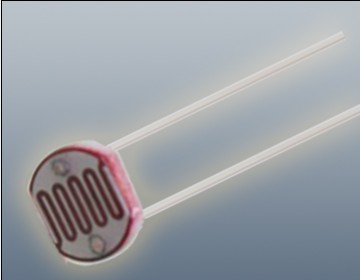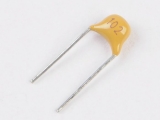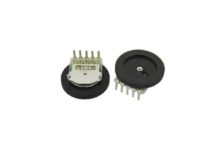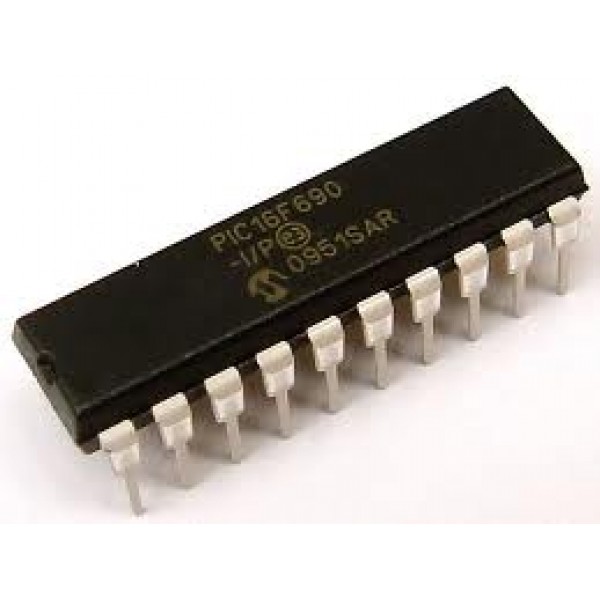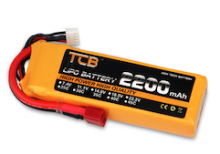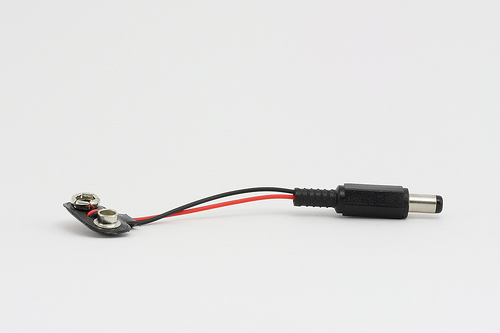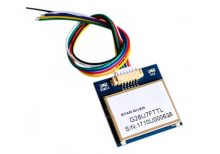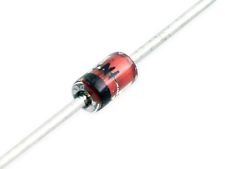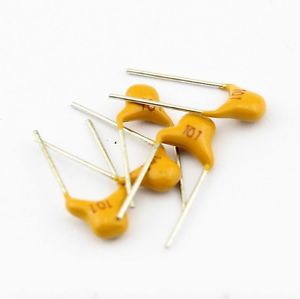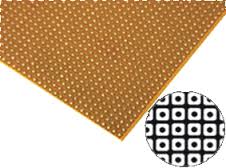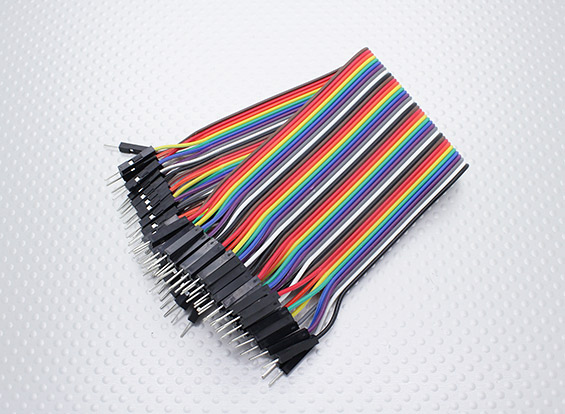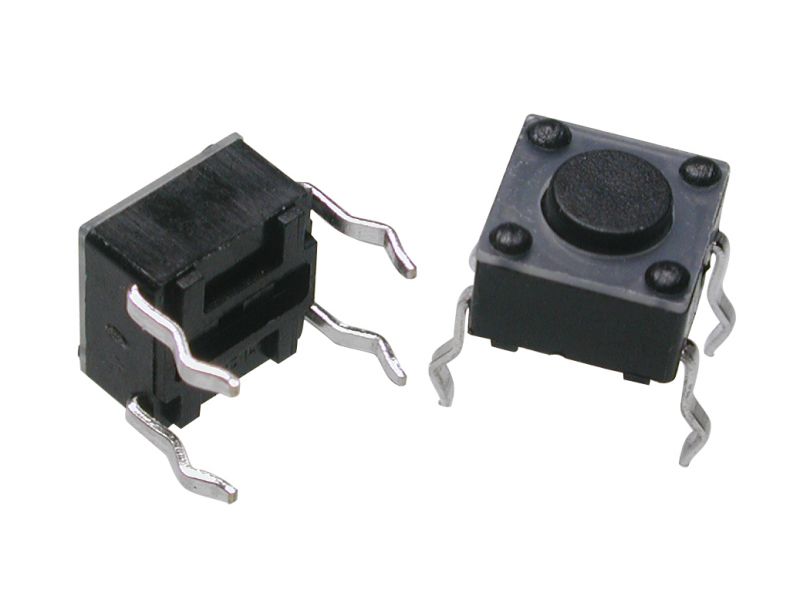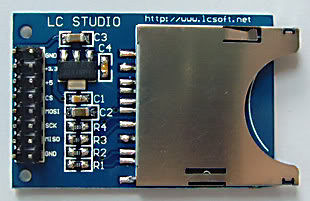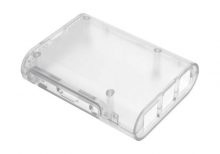|
Description |
The Photoresistor LDR (Light Dependent Resistor) is a variable resistor whose resistance changes with the light intensity that falls upon it. It is widely used in light sensing applications and projects where detecting light levels is essential. LDRs are cost-effective, easy to use, and suitable for various electronic projects, including light meters, street lights, and other light-sensitive devices.
Key Features:
- Light Sensitivity: Resistance decreases with increasing light intensity
- Simple Interface: Easy to integrate with microcontrollers and analog circuits
- Low Cost: Economical solution for light detection
- Wide Range of Light Detection: Can detect various light levels from low to high intensity
- Compact Size: Fits easily into small projects
Technical Specifications:
- Resistance in Darkness: Typically 1MΩ (depending on specific model)
- Resistance in Bright Light: Typically 10-20kΩ (depending on specific model)
- Spectral Peak: Approximately 540nm (most sensitive to green light)
- Response Time: Rise time ~20ms, fall time ~30ms
- Operating Temperature Range: -30°C to +70°C
- Diameter: Typically 5mm to 10mm (depending on specific model)
Applications:
- Light Meters: Measure light intensity for photography and scientific applications.
- Street Lights: Automatic on/off control based on ambient light levels.
- Alarm Systems: Detect changes in light levels for security purposes.
- Consumer Electronics: Light-sensitive control in devices like clocks and displays.
- Educational Projects: Common component in learning modules for electronics.
Usage:
- Circuit Integration: Connect the LDR in a voltage divider circuit with a fixed resistor to create a variable voltage output based on light intensity.
- Microcontroller Interface: Read the voltage output from the LDR circuit using an analog input pin on a microcontroller.
- Programming: Write code to interpret the analog signal and perform actions based on light levels (e.g., turning on an LED when it gets dark).
- Testing: Calibrate the LDR circuit for the desired light sensitivity by adjusting the fixed resistor value.
Caution:
- Environment: Avoid exposure to extreme temperatures and humidity, which may affect the LDR’s performance.
- Handling: Handle with care to avoid damaging the sensitive surface of the LDR.
Datasheet:
For detailed technical specifications, refer to the Photoresistor LDR Datasheet.
|
The 102 0.001uF 1nF 1000pF Monolithic Capacitor is a highly stable and reliable passive component used in a variety of electronic circuits. It is designed to offer excellent performance in filtering, coupling, decoupling, and timing applications, providing low loss and high precision.
Key Features:
- Capacitance: 1000pF (1nF, 0.001uF)
- Excellent temperature stability
- Low dissipation factor
- Durable and compact design
- Available in both leaded and surface mount configurations
- Wide operating temperature range
Technical Specifications:
- Capacitance: 1000pF (1nF, 0.001uF)
- Voltage Rating: 50V to 100V
- Tolerance: ±5%, ±10%
- Temperature Coefficient: ±30ppm/°C to ±50ppm/°C
- Operating Temperature Range: -55°C to +125°C
- Package Type: SMD or through-hole
Applications:
- Filtering and timing circuits
- RF and microwave applications
- Coupling and decoupling circuits
- Precision oscillators and resonators
- Audio and signal processing circuits
- General-purpose electronic applications
Usage:
- Determine the required capacitance and voltage rating for your application.
- Solder the capacitor onto the circuit board, ensuring correct polarity if applicable.
- Verify connections and integrate the capacitor into your circuit design.
- Test the circuit to ensure proper operation and performance.
Caution:
- Ensure the capacitor voltage rating is suitable for your circuit.
- Handle with care to prevent damage.
- Store in a cool, dry place to maintain component integrity.
- Avoid excessive heat exposure during soldering.
|
The 10k Single Gear Potentiometer is an adjustable resistor with a resistance range of 0 to 10 kΩ. It features a single gear mechanism for manual adjustment of resistance. This type of potentiometer is commonly used in various electronic circuits to control voltage, adjust signal levels, and fine-tune parameters.
Key Features:
- Resistance: 10 kΩ
- Type: Single gear (single-turn) potentiometer
- Adjustment Mechanism: Manual adjustment using a rotary knob
- Mounting Type: Typically through-hole or surface-mount
- Material: Usually made from conductive carbon or metal film
Technical Specifications:
- Resistance Range: 0 to 10 kΩ
- Tolerance: Typically ±10% or ±20% (depends on the model)
- Number of Turns: Single-turn (single gear)
- Maximum Power Rating: Usually up to 0.5W
- Temperature Coefficient: Varies by model, typically around ±100 ppm/°C
- Mounting Type: Through-hole or surface-mount (varies by design)
- Adjustment Type: Rotary knob or shaft
Applications:
- Volume Control: Used in audio equipment to adjust volume levels.
- Signal Adjustment: Ideal for fine-tuning signals in electronic circuits.
- Calibration: Useful for calibrating and setting parameters in various devices.
- Control Interfaces: Applied in user interfaces for controlling devices and systems.
- Prototyping: Commonly used in electronic prototypes and experimental setups.
Datasheet:
For detailed technical information, refer to the datasheet of the specific 10k single gear potentiometer model, as specifications can vary based on the manufacturer and design.
|
The PIC16F690 is a low-power 8-bit microcontroller from Microchip’s PIC16 family, designed for a range of applications requiring moderate processing power and peripheral integration. It offers an array of features including EEPROM memory, a variety of timers, and multiple I/O options, making it ideal for embedded control applications.
Key Features:
- 14-bit instruction set architecture
- 7-bit wide instruction set
- 384 bytes of RAM
- 128 bytes EEPROM
- 10-bit Analog-to-Digital Converter (ADC)
- Two Timer modules (Timer0 and Timer1)
- Watchdog Timer (WDT)
- Capture/Compare/PWM (CCP) module
- Low-power operation with multiple sleep modes
- Programmable code protection
Technical Specifications:
- Operating Voltage: 2.0V to 5.5V
- Operating Frequency: Up to 20MHz
- Program Memory Size: 7KB (Flash)
- Data Memory Size: 384 bytes SRAM
- EEPROM Size: 128 bytes
- Number of I/O Pins: 18
- Timers: 8-bit Timer0, 16-bit Timer1
- ADC Resolution: 10-bit
- Package Type: 14-pin PDIP, 14-pin SOIC, 14-pin SSOP
Applications:
- Consumer electronics
- Automotive control systems
- Industrial automation
- Home appliances
- Data acquisition systems
- Communication devices
Usage:
- Power the microcontroller within the recommended voltage range.
- Program the PIC16F690 using its Flash program memory to suit application needs.
- Utilize the ADC for analog signal processing and Timer modules for precise timing tasks.
- Interface with peripherals and manage power consumption using available sleep modes.
Caution:
- Verify power supply connections to prevent damage.
- Ensure proper handling to avoid electrostatic discharge (ESD) damage.
- Adhere to maximum current ratings for I/O pins to prevent overloading.
Datasheet:
For detailed technical specifications, refer to the PIC16F690 Datasheet.
|
The 2 AA Battery Casing is a compact and convenient holder designed to securely house two AA batteries. This battery casing is ideal for providing a portable power source for various electronic projects, toys, remote controls, and other battery-powered devices. It features durable construction and easy-to-use connectors, ensuring reliable and consistent power delivery to your devices.
Key Features:
- Secure Housing: Holds two AA batteries securely in place
- Durable Construction: Made from high-quality plastic for long-lasting use
- Easy Installation: Snap-fit design for quick and easy battery replacement
- Wire Leads: Pre-attached wire leads for easy connection to your device
- Portable Power Source: Ideal for various DIY electronics and hobby projects
Technical Specifications:
- Battery Type: AA (1.5V each)
- Number of Batteries: 2
- Output Voltage: 3V (when using two 1.5V AA batteries)
- Material: High-quality plastic
- Wire Leads: Typically 150mm in length, pre-tinned for easy soldering
- Dimensions: Approximately 58mm x 33mm x 15mm (L x W x H)
- Weight: Lightweight design for portability
Applications:
- DIY electronics projects
- Battery-powered toys
- Remote controls
- Flashlights
- Educational kits and prototypes
- Portable power supplies
Usage:
- Insert two AA batteries into the casing, ensuring correct polarity.
- Connect the wire leads to your device’s power input, observing correct polarity.
- Secure the casing in place within your project or device.
- Replace batteries as needed to maintain power supply.
Caution:
- Ensure correct battery polarity to avoid damage to the casing or connected device.
- Use high-quality batteries for optimal performance.
- Do not mix old and new batteries or different types of batteries.
- Protect the casing from water and extreme temperatures to ensure longevity.
Datasheet:
For detailed technical specifications, refer to the 2 AA Battery Casing Datasheet.
|
The TCB 4S 14.8V 35C 2200mAh LiPo Battery is a high-performance lithium polymer battery designed for RC models, drones, and other high-power applications. It provides a reliable and consistent power source with a high discharge rate, ensuring optimal performance and extended run times for your devices.
Key Features:
- High Capacity: 2200mAh for extended usage and longer run times.
- High Discharge Rate: 35C continuous discharge rate, ideal for high-power applications.
- 4S Configuration: 14.8V for powerful performance in compatible devices.
- Lightweight and Compact: Designed for ease of installation and portability.
- Durable Construction: Built to withstand the demands of RC and drone use.
Technical Specifications:
- Capacity: 2200mAh
- Voltage: 14.8V (4S)
- Discharge Rate: 35C continuous
- Dimensions: 105mm x 34mm x 26mm (approx.)
- Weight: 250g (approx.)
- Connector Type: XT60 or similar (specify actual connector if different)
- Balance Connector: JST-XH
Applications:
- RC Models: Ideal for RC cars, boats, airplanes, and helicopters.
- Drones: Suitable for various types of drones requiring high-power batteries.
- FPV Systems: Provides reliable power for FPV racing and freestyle drones.
- High-Power Applications: Any device or project requiring a high-capacity, high-discharge LiPo battery.
|
The PIC16F876A is an 8-bit microcontroller from Microchip Technology, known for its versatility and ease of use in a wide range of embedded applications. It features a RISC architecture, with a rich instruction set and extensive peripheral support. This microcontroller is ideal for use in industrial automation, consumer electronics, automotive, and home appliances.
Key Features:
- 8-bit RISC architecture
- 14-bit instruction set
- 7.37 kB (8192 words) Flash memory for program storage
- 368 bytes SRAM for data storage
- 256 bytes EEPROM for non-volatile data storage
- 22 I/O pins for interfacing with external devices
- 3 Timers (2 x 8-bit, 1 x 16-bit)
- 10-bit ADC with 8 channels
- Capture/Compare/PWM (CCP) modules
- Enhanced USART module for serial communication
- Master Synchronous Serial Port (MSSP) supporting SPI and I2C
- Watchdog Timer with dedicated on-chip RC oscillator
- Programmable code protection
- In-Circuit Serial Programming (ICSP) via two pins
Technical Specifications:
- Package Types: 28-pin PDIP, SOIC, SSOP, QFN
- Operating Voltage: 2.0V to 5.5V
- Clock Speed: Up to 20 MHz
- Flash Memory: 7.37 kB
- SRAM: 368 bytes
- EEPROM: 256 bytes
- I/O Pins: 22
- Timers: Two 8-bit, one 16-bit
- ADC Resolution: 10-bit
- ADC Channels: 8
- Operating Temperature Range: -40°C to +85°C
Applications:
- Industrial automation
- Consumer electronics
- Automotive control systems
- Home appliances
- Security systems
- Data acquisition systems
- Robotics
Usage:
- Programming:
- Program the PIC16F876A using a compatible programmer or development kit.
- Utilize ICSP for convenient in-circuit programming and debugging.
- Peripheral Configuration:
- Configure I/O pins, timers, ADC, CCP modules, and communication interfaces via software.
- Use the integrated peripherals to interface with sensors, actuators, and other devices.
- Application Development:
- Write and upload firmware to the microcontroller using development environments such as MPLAB X IDE.
- Utilize libraries and example codes to speed up the development process.
- Deployment:
- Integrate the programmed microcontroller into your electronic circuit.
- Ensure proper power supply and signal connections to avoid damage and ensure optimal performance.
Caution:
- Handle the microcontroller with care to avoid damage from electrostatic discharge (ESD).
- Verify the correct power supply voltage and connections before powering the device.
- Follow the manufacturer’s guidelines for programming and operation to ensure reliability and longevity.
Datasheet:
For detailed technical specifications, refer to the PIC16F876A Datasheet.
|
The 20W Hot Melt Glue Gun is a versatile adhesive tool designed for use with hot glue sticks. It heats and melts glue sticks, allowing for quick and easy bonding of various materials such as wood, plastic, fabric, and metal. Ideal for crafting, DIY projects, and repairs, this glue gun provides precise control and strong adhesive bonds.
Key Features:
- 20W power rating for efficient heating and melting of glue
- Ergonomic design for comfortable handling
- Adjustable stand for stability during use
- Quick heating time for faster work
- Compatible with standard hot glue sticks (usually 7mm or 11mm diameter)
- On/Off switch for convenient operation
Technical Specifications:
- Power Rating: 20W
- Voltage: Typically 220V AC (varies by region)
- Heat Time: Approximately 3-5 minutes to reach operating temperature
- Temperature Range: Approximately 160°C to 180°C (320°F to 356°F)
- Glue Stick Diameter: Compatible with 7mm or 11mm diameter glue sticks
- Weight: Typically around 150-200 grams
- Material: Plastic body with metal nozzle
Applications:
- Crafting and DIY projects
- Repairs of household items and electronics
- Assembly of wooden, plastic, and metal parts
- Artistic and creative projects
- General-purpose adhesive applications
Usage:
- Insert the glue stick into the rear of the glue gun.
- Plug in the glue gun and turn it on using the switch.
- Wait for 3-5 minutes for the glue gun to heat up and melt the glue.
- Squeeze the trigger to apply the molten glue to the surfaces you wish to bond.
- Hold the surfaces together until the glue sets (usually within 10-20 seconds).
- Turn off the glue gun and unplug it when not in use.
Caution:
- Handle the glue gun carefully to avoid burns from the hot glue and the heated nozzle.
- Ensure the glue gun is placed on a heat-resistant surface or its stand while in use.
- Keep out of reach of children and follow the manufacturer’s safety instructions.
Datasheet:
For detailed technical specifications, refer to the 20W Hot Melt Glue Gun Datasheet.
|
The P87C51 is an 8-bit microcontroller from the MCS-51 family, widely used in embedded systems and applications requiring control and automation. It features a robust set of peripherals and is compatible with the standard 8051 instruction set, making it suitable for various industrial, consumer, and automotive applications.
Key Features:
- 8-bit microcontroller based on the MCS-51 architecture
- 4KB of in-system programmable ROM
- 128 bytes of on-chip RAM
- 32 programmable I/O lines
- Two 16-bit timer/counters
- Full-duplex UART for serial communication
- On-chip oscillator and clock circuitry
- Interrupt support with two priority levels
- Watchdog timer for system reliability
- Low-power idle and power-down modes
Technical Specifications:
- CPU: 8-bit 8051 core
- ROM: 4KB
- RAM: 128 bytes
- EEPROM: None (external EEPROM can be used if needed)
- I/O Pins: 32 (four 8-bit ports)
- Timers/Counters: Two 16-bit
- Serial Communication: UART
- Operating Voltage: 4.0V to 5.5V
- Clock Frequency: Up to 24 MHz
- Power Consumption: Low power modes available
- Operating Temperature Range: -40°C to +85°C
- Package Type: DIP-40, PLCC-44, or QFP-44
Applications:
- Industrial control systems
- Consumer electronics
- Automotive systems
- Home automation
- Robotics
- Data acquisition systems
Usage:
- Program the P87C51 using an appropriate programmer with the desired firmware.
- Connect the necessary peripherals and sensors to the microcontroller’s I/O pins.
- Configure the microcontroller’s settings and features via software.
- Integrate the microcontroller into your electronic circuit for specific tasks and control functions.
Caution:
- Ensure proper handling and storage to avoid damage from electrostatic discharge (ESD).
- Verify correct power supply voltage and connections before powering the device.
- Follow the manufacturer’s guidelines for programming and operation.
Datasheet:
For detailed technical specifications, refer to the P87C51 Datasheet.
|
The Arduino 9V Battery Connector is a convenient accessory for powering Arduino boards and other compatible devices. It allows you to connect a standard 9V battery to the Arduino’s power jack, providing a portable power solution for your projects. This connector is essential for mobile and battery-operated applications, offering an easy and reliable way to supply power to your electronics.
Key Features:
- Compatible with standard 9V batteries
- Easy to connect and use
- Provides a secure and stable power connection
- Compact and portable design
- Durable construction for long-lasting use
- Standard DC barrel plug compatible with Arduino boards
Technical Specifications:
- Connector Type: DC barrel plug (center-positive)
- Barrel Plug Dimensions: Outer diameter 5.5mm, inner diameter 2.1mm
- Battery Connector Type: Snap-on connector for 9V battery
- Cable Length: Approximately 15 cm
- Material: Plastic and metal connectors with insulated wire
- Color: Typically black with red and black wires
Applications:
- Portable Arduino projects
- Battery-operated electronics
- Prototyping and testing
- Educational kits
- DIY electronics
Usage:
- Connection:
- Snap the 9V battery connector onto the terminals of a standard 9V battery.
- Insert the DC barrel plug into the power jack of your Arduino board or compatible device.
- Powering:
- Ensure the polarity of the connections is correct (center-positive) to avoid damage to the board.
- The Arduino will draw power from the 9V battery through the connector.
- Monitoring:
- Monitor the battery voltage periodically to ensure it remains within the acceptable range for your Arduino board (typically 7-12V).
Caution:
- Ensure the connector is securely attached to the battery terminals to prevent intermittent connections.
- Avoid short-circuiting the battery terminals.
- Do not expose the connector to moisture or extreme temperatures.
- Remove the battery from the connector when not in use to prevent battery drain.
Datasheet:
Refer to the manufacturer’s guidelines or specifications for further details.
|
The VK2828 G28U7FTTL is a high-performance GPS module designed for aviation and other high-precision applications. It features a wide range of operational frequencies and is capable of delivering accurate positional data for navigation and tracking purposes. The module is ideal for integration into systems requiring reliable and precise GPS information.
Key Features:
- High Update Rate: Capable of updating position data from 1Hz to 10Hz, allowing for smooth and accurate tracking
- Sensitivity: Designed for use in aviation, providing robust performance in various environmental conditions
- Compatibility: Supports standard GPS protocols for easy integration into existing systems
- Compact Size: Suitable for integration into space-constrained applications
Technical Specifications:
- Type: GPS Module
- Model: VK2828 G28U7FTTL
- Update Rate: 1Hz to 10Hz
- Frequency Range: Supports standard GPS frequencies
- Sensitivity: High sensitivity for accurate positioning
- Protocol: NMEA-0183
- Operating Voltage: Typically 3.3V to 5V DC
- Power Consumption: Low power consumption for battery-operated applications
- Dimensions: Varies by model, generally compact for easy integration
- Antenna: May include an external or integrated antenna depending on the model
Applications:
- Aviation: Navigation and tracking for aircraft
- Marine: Boat and ship navigation
- Automotive: Advanced driver-assistance systems (ADAS)
- Outdoor Activities: Hiking and sports tracking
- Industrial: Asset tracking and fleet management
Usage:
- Powering the Module: Connect the GPS module to a suitable power source within the specified voltage range.
- Connecting the Antenna: Ensure the antenna is properly connected and positioned for optimal signal reception.
- Data Integration: Use the NMEA protocol to receive GPS data, including latitude, longitude, altitude, and time.
- Integration: Connect the GPS module to your system or application for real-time tracking and navigation.
Caution:
- Signal Reception: Ensure the module has a clear view of the sky for optimal GPS signal reception.
- Voltage: Verify the operating voltage to avoid damage to the module.
- Antenna Placement: Position the antenna to minimize interference and maximize signal strength.
Datasheet:
For detailed technical specifications, refer to the VK2828 G28U7FTTL Datasheet .
|
The 222 0.0022µF ceramic capacitor is a small, non-polarized capacitor with a capacitance of 2.2 nanofarads (nF) or 2200 picofarads (pF). It is used in various electronic circuits for filtering, decoupling, and timing applications. The ceramic material offers stability and reliability in different environments, making it a common choice for both commercial and industrial applications.
Key Features:
- Capacitance of 0.0022µF (2.2nF, 2200pF)
- Non-polarized construction
- Stable and reliable ceramic material
- Typically available in various tolerance and temperature coefficient options
- Suitable for high-frequency applications due to low equivalent series resistance (ESR)
Technical Specifications:
- Capacitance: 0.0022µF (2.2nF, 2200pF)
- Tolerance: Typically ±10% or ±20% (varies by manufacturer)
- Voltage Rating: Commonly 50V, 100V, or 250V (varies by manufacturer)
- Temperature Coefficient: Varies by type, such as C0G, X7R, Y5V
- Body Size: Small, often with dimensions around 1.6mm x 0.8mm for SMD or similar for through-hole versions
- Mounting Type: Surface-mount (SMD) or through-hole
Applications:
- Filtering: Used in power supply circuits to filter out noise and stabilize voltage.
- Decoupling: Provides decoupling for digital ICs to prevent signal interference.
- Timing Circuits: Utilized in timing and oscillator circuits due to stable capacitance values.
- Signal Coupling: Coupling AC signals between stages in analog circuits.
- High-Frequency Applications: Suitable for high-frequency circuits due to low ESR.
Usage:
- Identify the required capacitance value and voltage rating for your application.
- Choose the appropriate capacitor type (SMD or through-hole) based on your PCB design.
- Place the capacitor in the correct position on the PCB or circuit board.
- For SMD capacitors, use a reflow soldering process; for through-hole, solder the leads manually.
- Verify circuit performance to ensure the capacitor is functioning as intended.
Caution:
- Ensure the voltage rating of the capacitor exceeds the maximum voltage in the circuit to avoid breakdown.
- Handle with care to avoid damage to the ceramic material.
- Verify the capacitance value and tolerance to match circuit requirements.
|
The Hub360 Arduino Starter Kit is a comprehensive package designed for beginners and enthusiasts looking to dive into the world of electronics and programming. This kit includes Arduino Uno, which is a microcontroller board based on the ATmega328P. The kit provides a variety of components and modules to help users learn and experiment with different electronic projects and concepts.
Key Features:
- Includes Arduino Uno board
- Comprehensive set of components and modules for various projects
- Ideal for beginners and hobbyists
- Detailed tutorial and project guide included
- USB interface for easy programming and power
- Compatible with Arduino IDE and various libraries
Technical Specifications:
- Microcontroller: ATmega328P
- Operating Voltage: 5V
- Input Voltage (recommended): 7-12V
- Digital I/O Pins: 14 (6 PWM outputs)
- Analog Input Pins: 6
- DC Current per I/O Pin: 20mA
- Flash Memory: 32KB (ATmega328P) of which 0.5KB used by bootloader
- SRAM: 2KB (ATmega328P)
- EEPROM: 1KB (ATmega328P)
- Clock Speed: 16 MHz
Kit Contents:
- ARDUINO BOARD 1
- ARDUINO USB CABLE 1
- ARDUINO BATTERY CONNECTOR 1
- 400 HOLE BREADBOARD 1
- LED (RED, YELLOW , GREEN, WHITE) 20
- RGB LED 1
- JUMPER WIRE(M-M, M-F, F-F) 120
- PHOTORESISTOR (LDR) 3
- MALE HEADERS 40
- ULTRASONIC SENSOR 1
- FLAME SENSOR 1
- TEMP./HUMIDITY SENSOR 1
- TILT SENSOR 1
- LASER SENSOR 1
- PIR MOTION SENSOR 1
- RESISTORS(220K, 1K, 10K,100K) 40
- 7 SEGMENT DISPLAY 1
- SG90 SERVO 1
- REMOTE CONTROL 1
- BUZZER 1
- 2N2222 2
- TSOP 1838 1
- RF TRANSMITTER 1
- RF RECEIVER 1
- TACT SWITCH 5
- 16*2 LCD DISPLAY
Applications:
- Learning basic electronics and programming
- Building interactive projects and prototypes
- Developing skills in microcontroller-based design
- Experimenting with sensors and actuators
- Creating DIY electronic devices
Usage:
- Setup:
- Connect the Arduino Uno board to your computer using the USB cable.
- Install the Arduino IDE and configure it to recognize the board.
- Programming:
- Write or upload sample code (sketches) to the Arduino board using the Arduino IDE.
- Utilize the provided components and modules to build and test different circuits.
- Experimentation:
- Follow the detailed tutorials and project guide to create various projects.
- Modify and expand on the sample projects to enhance learning and creativity.
Caution:
- Handle the components carefully to avoid damage.
- Ensure proper connections and polarity to prevent short circuits or component failure.
- Verify the code and circuit connections before powering the board.
Datasheet:
For detailed technical specifications of the Arduino Uno, refer to the Arduino Uno Datasheet.
|
The 1N4744A is a Zener diode designed to provide a stable reference voltage of 15V with a power dissipation of 1W. This Zener diode is used in electronic circuits for precise voltage regulation, voltage referencing, and overvoltage protection. It offers reliable performance for general-purpose applications.
Key Features:
- Nominal Zener Voltage: 15V
- Power Dissipation: 1W
- Tight tolerance for accurate voltage regulation
- Low leakage current
- High stability and reliability
- Axial-leaded design for easy PCB mounting
Technical Specifications:
- Zener Voltage (Vz): 15V
- Test Current (Iz): 20mA
- Maximum Zener Impedance (Zz): 60 ohms at Iz
- Maximum Reverse Leakage Current (Ir): 0.5µA at Vr = 12V
- Power Dissipation (Pd): 1W
- Operating Temperature Range: -65°C to +200°C
- Package Type: DO-41 (Axial)
- Dimensions: Length: 4.5mm, Diameter: 2.0mm (approx.)
Applications:
- Voltage Regulation: Provides a stable reference voltage for various circuits.
- Overvoltage Protection: Protects sensitive electronic components from voltage spikes.
- Voltage Clamping: Limits the voltage to a specific value to protect circuits.
- Signal Conditioning: Used in waveform clipping and shaping circuits.
- Reference Voltage: Provides a precise reference voltage in measurement and control systems.
Usage:
- Identify the correct placement for the Zener diode in your circuit based on the schematic.
- Ensure the Zener diode’s voltage and power rating match the circuit’s requirements.
- Solder the Zener diode into place, observing proper polarity (cathode marked with a band).
- Test the circuit to verify the Zener diode is functioning as expected.
Caution:
- Ensure the Zener diode’s power rating is not exceeded to prevent overheating and failure.
- Handle with care to avoid damaging the diode during installation.
- Verify the Zener diode’s specifications match the requirements of your application.
Datasheet:
For detailed technical specifications, refer to the 1N4744A Zener Diode Datasheet.
|
A line tracking sensor is an infrared-based module used for detecting and following lines or paths on surfaces. It is commonly employed in robotics and automated systems to navigate predefined routes or tracks.
Key Features:
- Sensor Type: Infrared (IR) sensor module.
- Detection Method: Typically uses infrared light emitted by LEDs and reflected off the surface.
- Detection Capability: Can detect lines of contrasting colors (typically black on white or vice versa).
- Output: Digital signals indicating line detection (e.g., high or low) or analog signals proportional to the position on the line.
- Operating Voltage: Usually operates at 5V DC.
- Adjustability: Often adjustable sensitivity to fine-tune detection based on line width and surface reflectivity.
- Integration: Compact and designed for easy integration into robotic systems or line-following vehicles.
- Mounting: Typically includes mounting holes or brackets for easy installation.
Technical Specifications:
- Dimensions: Compact size suitable for various robotic applications.
- Operating Range: Suitable for indoor and controlled outdoor environments.
- Response Time: Fast response to changes in line position.
- Operating Temperature: Typically -10°C to +50°C.
Applications:
- Automated guided vehicles (AGVs)
- Line-following robots
- Industrial automation
- Educational robotics projects
Datasheet: For detailed technical information, refer to the Line Tracking Sensor datasheet.
|
The 101 0.0001uF 0.1nF 100pF Monolithic Capacitor is a high-quality, stable, and reliable passive electronic component designed for a wide range of applications. It features excellent temperature stability and low-loss characteristics, making it ideal for use in filters, timing circuits, and other precision applications.
Key Features:
- Capacitance: 100pF (0.1nF, 0.0001uF)
- Excellent temperature stability
- Low dissipation factor
- High reliability and long lifespan
- Small and compact size
- Leaded or surface mount design options
- Wide operating temperature range
Technical Specifications:
- Capacitance: 100pF (0.1nF, 0.0001uF)
- Voltage Rating: 50V to 100V
- Tolerance: ±5%, ±10%
- Temperature Coefficient: ±30ppm/°C to ±50ppm/°C
- Operating Temperature Range: -55°C to +125°C
- Package Type: SMD or through-hole
Applications:
- Filters and timing circuits
- RF and microwave circuits
- Coupling and decoupling applications
- Precision oscillators and resonators
- Audio and signal processing equipment
- General-purpose electronic circuits
Usage:
- Identify the required capacitance and voltage rating for your application.
- Solder the capacitor onto the circuit board, ensuring correct polarity if applicable.
- Verify the connections and integrate the capacitor into your circuit design.
- Test the circuit to ensure proper functionality and performance.
Caution:
- Ensure the capacitor voltage rating matches or exceeds the circuit requirements.
- Handle with care to avoid damaging the component.
- Store in a cool, dry place to maintain capacitor integrity.
- Avoid exposure to excessive heat during soldering.
|
A small size dotted Vero board, also known as a stripboard or prototyping board, is a type of circuit board that is used for prototyping and building electronic circuits. It features a grid of holes with copper pads that allow components to be easily soldered onto the board. The dotted pattern provides flexibility in layout, making it ideal for custom circuit designs and small electronic projects.
Key Features:
- Dotted pattern for versatile circuit layout
- High-quality FR4 material for durability
- Copper pads for easy soldering
- Small size for compact projects
- Compatible with through-hole components
- Suitable for prototyping and custom circuit building
Technical Specifications:
- Material: FR4 (fiberglass epoxy laminate)
- Size: Typically around 70mm x 90mm (varies by manufacturer)
- Hole Pitch: 2.54mm (standard 0.1 inch grid)
- Hole Diameter: 1.0mm (suitable for most through-hole components)
- Thickness: 1.6mm
- Copper Thickness: 35µm (1oz/ft²)
- Pattern: Dotted (individual copper pads)
- Number of Holes: Varies by board size (e.g., 25×35 grid for 70mm x 90mm board)
Applications:
- Prototyping electronic circuits
- Custom circuit design
- DIY electronics projects
- Educational and learning purposes
- Small-scale production of custom circuits
Usage:
- Design the Circuit:
- Plan the layout of your components and connections on the Vero board.
- Place the Components:
- Insert the components into the holes according to your circuit design.
- Solder the Components:
- Solder the component leads to the copper pads on the reverse side of the board.
- Create Connections:
- Use solder bridges or wire links to create electrical connections between the copper pads as needed.
- Test the Circuit:
- Verify the circuit functionality and make any necessary adjustments or corrections.
Caution:
- Ensure proper soldering techniques to avoid short circuits or poor connections.
- Handle the board carefully to avoid damaging the copper pads or FR4 material.
- Verify the component placement and connections before powering the circuit.
|
A small magnifying glass is a handheld optical device used to magnify small objects, making them appear larger for easier viewing. It is commonly used in applications such as reading small text, inspecting small objects, detailed crafts, and electronics work. Small magnifying glasses are portable, easy to use, and often come with additional features like built-in lights for enhanced visibility.
Key Features:
- Magnification: Typically ranges from 2x to 10x magnification
- Lens Diameter: Small lens diameters, commonly around 25 mm to 75 mm
- Material: Lenses are usually made from glass or high-quality acrylic
- Handle: Ergonomically designed handles for comfortable grip
- Additional Features: Some models come with built-in LED lights for better illumination
Technical Specifications:
- Magnification Power: Commonly available in 2x, 3x, 5x, 7x, and 10x magnifications
- Lens Diameter: Varies from 25 mm to 75 mm
- Lens Material: Optical glass or acrylic
- Frame Material: Plastic or metal
- Handle: Often plastic, rubber-coated, or metal with ergonomic design
- Weight: Typically lightweight, around 20 g to 100 g
Applications:
- Reading: Enhances the readability of small text in books, newspapers, and maps.
- Crafts and Hobbies: Useful for detailed work in model building, jewelry making, and other crafts.
- Electronics: Assists in inspecting small components, solder joints, and circuit boards.
- Biology and Botany: Helps in examining small specimens like insects and plant parts.
- Everyday Use: Handy for reading labels, menus, and other small print items.
Datasheet:
Small magnifying glasses generally do not have detailed datasheets, but the manufacturer or supplier can provide specifications.
|
The AT24C512 is a 512-Kbit Electrically Erasable Programmable Read-Only Memory (EEPROM) organized as 65,536 words of 8 bits each. It is a high-density memory device used in a wide range of applications including industrial, automotive, and consumer electronics. The AT24C512 uses an I²C interface for communication, making it easy to integrate into various systems.
Key Features:
- Memory Size: 512 Kbits (64 KB)
- Organization: 65,536 x 8
- Interface: I²C (Inter-Integrated Circuit)
- Operating Voltage: 1.7V to 5.5V
- Data Retention: 100 years
- Endurance: 1,000,000 write cycles
- Access Time: 1 ms (byte write)
- Package Types: Available in several packages including 8-lead SOIC, TSSOP, and PDIP
Technical Specifications:
- Memory: 512 Kbits (64 KB)
- Interface: I²C-compatible (two-wire serial interface)
- Clock Frequency: Up to 1 MHz for Fast-mode Plus (FM+)
- Write Protection: Hardware write protection available via WP pin
- Temperature Range: -40°C to 85°C (industrial grade)
- Package Options: 8-lead SOIC, 8-lead TSSOP, 8-lead PDIP
- Dimensions: Varies by package, e.g., SOIC-8: 5.0 mm x 4.0 mm x 1.5 mm (typical)
Applications:
- Consumer Electronics: Used in televisions, remote controls, and gaming consoles.
- Industrial Control: Employed in data logging, sensor calibration, and system configuration storage.
- Automotive: Utilized in engine control units, infotainment systems, and other in-vehicle electronics.
- Medical Devices: Stores calibration data and patient information.
- Networking Equipment: Used in routers, switches, and other network devices for configuration settings.
Datasheet:
For detailed technical information, refer to the AT24C512 EEPROM Datasheet provided by the manufacturer.
|
The 4×4 Matrix Keypad is a user-friendly input device consisting of 16 keys arranged in a 4×4 matrix. It is widely used in embedded systems, microcontroller projects, and DIY electronics for user input. Each key press is detected by scanning the matrix, allowing for efficient and reliable data entry. The keypad is compact, durable, and easy to integrate into various projects.
Key Features:
- Key Configuration: 4 rows and 4 columns, totaling 16 keys
- Interface: Matrix scanning
- Key Labels: Numeric and function keys (0-9, A-D, *, #)
- Compact Design: Suitable for handheld devices and small projects
- Durable: Made from high-quality materials for long-lasting use
- Flexible: Can be connected to any microcontroller or development board
- Low Power Consumption: Efficient operation with minimal power usage
Technical Specifications:
- Number of Keys: 16 (4×4 matrix)
- Operating Voltage: 3.3V to 5V
- Current Consumption: < 10mA
- Contact Resistance: ≤ 200 ohms
- Insulation Resistance: ≥ 100M ohms (at 250V DC)
- Operating Temperature Range: -20°C to +60°C
- Keypad Dimensions: 69mm x 69mm x 1.8mm
- Connection Type: 8-pin header
Applications:
- Embedded Systems: User input for microcontroller-based projects.
- DIY Electronics: Ideal for hobbyists and makers creating custom projects.
- Access Control: Use in security systems for code entry.
- Consumer Electronics: Keypad input for appliances and gadgets.
- Educational Projects: Commonly used in educational kits and learning modules.
Usage:
- Wiring: Connect the 8-pin header to the microcontroller or development board, ensuring correct row and column connections.
- Programming: Use libraries (e.g., Keypad library for Arduino) to read key presses and handle input.
- Integration: Incorporate the keypad into your project for reliable user input.
- Testing: Verify the functionality by pressing keys and checking the output.
Caution:
- Proper Connection: Ensure the keypad is connected correctly to avoid malfunction.
- Voltage Levels: Operate within the specified voltage range to prevent damage.
Datasheet:
For detailed technical specifications, refer to the 4×4 Matrix Keypad Datasheet.
|
The Male-Male Jumper Wires (Set) is an essential component for breadboarding and prototyping in electronics projects. These wires are used to establish quick and reliable connections between various points in a circuit, such as between the pins of a microcontroller, sensors, modules, and other components. The set typically includes a variety of lengths and colors to help with organizing and identifying connections.
Key Features:
- Easy and quick connections for breadboards and other prototyping environments
- Variety of lengths and colors for flexibility and organization
- Durable and reusable
- Compatible with standard 0.1” (2.54mm) pitch headers
- Ideal for Arduino, Raspberry Pi, and other microcontroller projects
Technical Specifications:
- Connector Type: Male to Male
- Pin Spacing: 0.1” (2.54mm)
- Wire Lengths: Varies (typically 10cm, 20cm, and 30cm)
- Wire Gauge: 24 AWG
- Insulation Material: PVC
- Conductor Material: Copper or copper-clad aluminum
- Colors: Multiple (e.g., red, blue, green, yellow, black, white)
- Quantity: Typically 40 wires per set (may vary)
Applications:
- Breadboarding and prototyping
- Microcontroller and development board projects
- Interfacing sensors and modules
- Educational and DIY electronics projects
- Connecting components in a temporary setup
Usage:
- Connecting Components:
- Use the jumper wires to connect the pins of different components on a breadboard or between header pins on development boards.
- Ensure firm and secure connections by inserting the male ends into the breadboard or header sockets.
- Organizing Circuits:
- Use different colors to identify various connections and signals, making the circuit easier to debug and understand.
- Select appropriate wire lengths to minimize clutter and ensure neat and organized prototyping.
- Reusability:
- Jumper wires can be reused in multiple projects, making them a cost-effective solution for prototyping.
Caution:
- Handle with care to avoid damaging the wire insulation or connectors.
- Ensure correct connections to avoid short circuits or incorrect wiring.
- Store in a dry and cool place to maintain the integrity of the connectors and insulation.
Datasheet:
Refer to the specific manufacturer’s datasheet or product details for more information if available.
|
A Tact Switch, also known as a tactile switch, is a type of switch designed to provide a tactile feedback when pressed. These switches are commonly used in electronic devices for user input, such as in keyboards, remote controls, and various consumer electronics. Tact switches are known for their compact size, reliability, and ease of integration into circuits.
Key Features:
- Tactile Feedback: Provides a satisfying click feel when pressed.
- Compact Size: Small and suitable for space-constrained applications.
- Reliability: Durable and designed for a high number of actuation cycles.
- Variety of Sizes: Available in different sizes and heights to fit various designs.
- Easy Mounting: Can be mounted on PCBs with through-hole or surface-mount technology.
- Wide Application Range: Suitable for a variety of electronic devices and applications.
Technical Specifications:
- Contact Rating: Typically 50mA, 12V DC
- Contact Resistance: ≤ 100mΩ
- Insulation Resistance: ≥ 100MΩ at 100V DC
- Dielectric Strength: 250V AC for 1 minute
- Operating Force: Typically 160gf (varies by model)
- Travel: Typically 0.25mm to 0.5mm
- Operating Life: Typically 100,000 to 1,000,000 cycles
- Operating Temperature Range: -20°C to +70°C
Applications:
- Consumer Electronics: Used in remote controls, calculators, and gaming controllers.
- Computer Peripherals: Keyboards, mice, and other input devices.
- Home Appliances: Control panels for microwaves, washing machines, and other appliances.
- Automotive: Control buttons on car dashboards and steering wheels.
- Industrial Equipment: Control panels and user interfaces for machinery.
- DIY Projects: Suitable for custom electronic projects and prototypes.
Usage:
- Mounting: Solder the tact switch onto a PCB, ensuring correct alignment of the pins.
- Wiring: Connect the switch to your circuit, typically using pull-up or pull-down resistors.
- Testing: Verify the switch functionality by pressing it and checking the response in your circuit.
- Integration: Integrate the switch into your final product, ensuring it is accessible and functions as intended.
Caution:
- Debouncing: Implement debouncing in your software to ensure accurate readings.
- Proper Soldering: Avoid excessive heat during soldering to prevent damage to the switch.
- Environmental Conditions: Ensure the switch is used within its specified temperature and humidity range.
Datasheet:
For detailed technical specifications, refer to the Tact Switch Datasheet.
|
The L298N Dual H Bridge DC Stepper Motor Driver is a robust and versatile module used for controlling DC and stepper motors in various electronic projects. This driver module can control the speed and direction of two DC motors or a single stepper motor, making it ideal for robotics, automation, and other motor control applications. It features an onboard 5V regulator and can handle high currents, ensuring reliable operation in demanding environments.
Key Features:
- Motor Control: Dual H Bridge for controlling two DC motors or one stepper motor
- Voltage Range: Supports motor voltage from 5V to 35V
- Current Handling: Each bridge can handle up to 2A
- Onboard 5V Regulator: Provides 5V output for powering external circuits
- Control Pins: Enable and direction control for each motor
- Protection: Built-in thermal shutdown and overcurrent protection
- Compact Design: Easy to integrate into various projects
Technical Specifications:
- Motor Voltage: 5V to 35V
- Current Handling: 2A per bridge (peak 3A)
- Logic Voltage: 5V
- Control Inputs: 4 (IN1, IN2, IN3, IN4) for direction control
- Enable Pins: 2 (EN1, EN2) for enabling the motors
- Output Voltage: 5V (when using onboard regulator)
- Dimensions: 43mm x 43mm x 27mm
Applications:
- Robotics: Control of DC motors and stepper motors in robots.
- Automation: Use in automated systems for precise motor control.
- DIY Projects: Ideal for hobbyists and makers building motorized projects.
- Industrial Control: Suitable for controlling motors in industrial equipment.
- Educational Kits: Commonly used in learning modules for motor control.
Usage:
- Power Supply: Connect the motor power supply to the VCC and GND terminals, ensuring it is within the specified voltage range.
- Motor Connection: Connect the DC motors or stepper motor to the output terminals (OUT1, OUT2, OUT3, OUT4).
- Control Inputs: Use the control pins (IN1, IN2, IN3, IN4) to set the direction of the motors. The enable pins (EN1, EN2) can be used to enable or disable the motors.
- Logic Power: If using the onboard 5V regulator, connect the 5V and GND pins to your microcontroller or control circuit.
- Programming: Write code to control the motor speed and direction using PWM signals and logic inputs.
Caution:
- Heat Dissipation: The module can get hot during operation. Use a heat sink or cooling fan if necessary.
- Voltage and Current Limits: Do not exceed the specified voltage and current ratings to prevent damage.
Datasheet:
For detailed technical specifications, refer to the L298N Dual H Bridge DC Stepper Motor Driver Datasheet.
|
The SD Card Module is a compact and efficient solution for adding storage capabilities to your microcontroller or development board projects. It allows you to read from and write to SD cards, making it ideal for data logging, file storage, and other applications requiring large amounts of memory. The module supports various SD card formats and interfaces seamlessly with popular microcontrollers like Arduino, Raspberry Pi, and others.
Key Features:
- Storage: Supports SD, SDHC, and MicroSD (with adapter) cards
- Interface: SPI interface for easy integration
- Voltage Compatibility: Operates at 3.3V and 5V
- Onboard 3.3V Regulator: Ensures stable operation
- Card Detection: Built-in card detection switch
- Compact Design: Small footprint for easy incorporation into projects
- File System: Compatible with FAT16 and FAT32 file systems
Technical Specifications:
- Supported Cards: SD, SDHC, MicroSD (with adapter)
- Operating Voltage: 3.3V/5V
- Interface: SPI
- Current Consumption: < 100mA
- File System: FAT16, FAT32
- Dimensions: 42mm x 24mm x 12mm
Applications:
- Data Logging: Store sensor data and logs in embedded systems.
- File Storage: Save files for multimedia applications and projects.
- Firmware Updates: Load new firmware from the SD card for microcontrollers.
- DIY Projects: Perfect for hobbyists needing additional storage.
- Educational Projects: Commonly used in learning modules for data storage and retrieval.
Usage:
- Wiring: Connect the SD card module to your microcontroller using the SPI interface (CS, MOSI, MISO, SCK, VCC, GND).
- Power Supply: Ensure the module is powered with 3.3V or 5V, as required.
- Card Insertion: Insert a formatted SD card into the module.
- Programming: Use libraries (e.g., SD library for Arduino) to initialize the SD card and read/write data.
- Data Handling: Store or retrieve data files from the SD card as needed by your application.
Caution:
- Voltage Levels: Ensure proper voltage levels to avoid damaging the module.
- Handling SD Cards: Handle SD cards with care to prevent data loss or corruption.
Datasheet:
For detailed technical specifications, refer to the SD Card Module Datasheet.
|
The Raspberry Pi 3 Transparent Injection Case is a protective enclosure designed for the Raspberry Pi 3 Model B and Model B+. It provides a clear, durable case that allows easy viewing of the Raspberry Pi while protecting it from dust, damage, and physical impact. The case is made from high-quality injection-molded plastic, ensuring a precise fit and a sleek, modern look.
Key Features:
- Transparent design for visibility of the Raspberry Pi board
- Injection-molded plastic construction for durability
- Precise cutouts for all ports, connectors, and GPIO pins
- Easy access to SD card slot and USB ports
- Ventilation slots for effective heat dissipation
- Simple snap-together assembly; no tools required
- Includes mounting hardware and rubber feet for stability
Technical Specifications:
- Material: Transparent injection-molded plastic
- Compatibility: Raspberry Pi 3 Model B and Model B+
- Color: Clear/Transparent
- Dimensions: Varies slightly by manufacturer (typically around 90mm x 60mm x 30mm)
- Weight: Varies slightly by manufacturer (typically around 50g)
Applications:
- Protecting Raspberry Pi 3 during use and handling
- Displaying the Raspberry Pi while maintaining access to ports
- Enclosing Raspberry Pi in a professional or educational setting
- Enhancing the aesthetics of Raspberry Pi-based projects
Usage:
- Place the Raspberry Pi 3 into the case, aligning it with the cutouts and mounting points.
- Snap the case parts together to secure the Raspberry Pi in place.
- Ensure all ports and connectors are accessible through the case openings.
- Mount the case using the included rubber feet or screws if required.
Caution:
- Handle the case carefully to avoid scratches or cracks.
- Ensure proper ventilation to prevent overheating of the Raspberry Pi.
- Verify that all connectors and ports are aligned and accessible before use.
Datasheet:
For detailed technical specifications, refer to the Raspberry Pi 3 Transparent Injection Case database.
|
The LiPo Battery 7.4V 2400mAh is a rechargeable lithium polymer battery commonly used in high-performance applications such as drones, RC vehicles, and other electronics. Its high capacity and stable voltage make it suitable for applications requiring reliable and extended power supply. This battery offers a balance between size, weight, and power output.
Key Features:
- Voltage: 7.4V (nominal)
- Capacity: 2400mAh
- Chemistry: Lithium Polymer (LiPo)
- Discharge Rate: Typically high discharge rates available (e.g., 20C to 30C)
- Charge Rate: Safe charging rate, typically 1C (2400mA)
- Compact Design: Lightweight and compact for easy integration
- Protection Circuit: Often includes built-in protection to prevent overcharging and over-discharging (varies by manufacturer)
Technical Specifications:
- Dimensions:
- Length: 100 mm (typical)
- Width: 35 mm (typical)
- Height: 15 mm (typical)
- Weight: Approximately 150 g
- Nominal Voltage: 7.4V
- Capacity: 2400mAh
- Discharge Rate:
- Continuous: Typically 20C to 30C (e.g., 48A to 72A)
- Peak: Higher rates available depending on model
- Charge Rate: 1C (2400mA) or as specified by manufacturer
- Connector Type: JST or XT60 (varies by model)
- Battery Type: Lithium Polymer (LiPo)
- Protection Circuit: Built-in protection (varies by model)
Applications:
- Drones: Provides power for multirotor drones and other UAVs.
- RC Vehicles: Suitable for remote-controlled cars, boats, and planes.
- Electronics Projects: Ideal for DIY electronics and prototyping projects requiring reliable power.
- High-Power Devices: Used in devices requiring high discharge rates and extended battery life.
Datasheet:
For detailed technical information, refer to the LiPo Battery 7.4V 2400mAh Datasheet.
|
